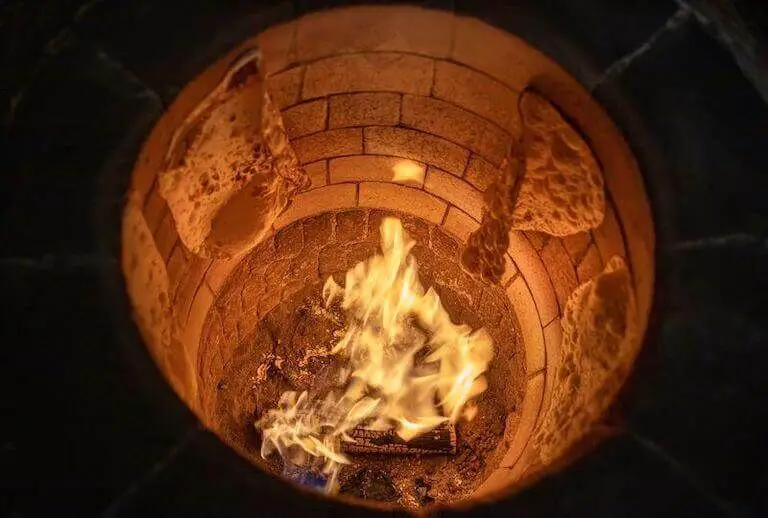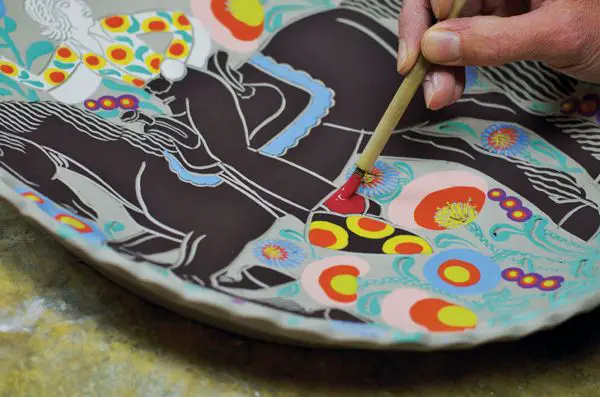What Is A Cylindrical Clay Oven?
What is a Cylindrical Clay Oven?
A cylindrical clay oven, also known as a tandoor, is a traditional clay oven originating from the Indian subcontinent, predominantly used in cooking and baking.
According to Merriam-Webster, a tandoor is defined as “a cylindrical clay oven in which food is cooked over charcoal.” [1]
The tandoor is traditionally made from clay or firebrick and has an opening at the top and bottom. It is shaped like a large vase or urn, with a diameter ranging from 1 to 3 feet. The heat for cooking is provided by a charcoal or wood fire at the bottom of the oven.
Food is either placed directly on the tandoor’s wall or put on long skewers and inserted vertically into the oven. The intense heat from the hot air circulating inside the tandoor allows for quick cooking and imparts a distinctive charred flavor.
Common dishes cooked in a tandoor clay oven include tandoori chicken, naan bread, kebabs, and tandoori roti. Vegetables like peppers, potatoes, and cauliflower are also popular items cooked in a tandoor.
Origins and History
Cylindrical clay ovens have a long history, with evidence of early use dating back thousands of years. According to Wikipedia, clay ovens were used in Palestine as early as the 1st and 2nd centuries CE. These early ovens often had an opening at the top and were equipped with a detachable flat lid.
In the Middle East and Asia, cylindrical clay ovens emerged as a common method of cooking and baking. As noted by the Encyclopedia, clay ovens were widely used in Yemen for both baking and cooking meals. These traditional Yemeni ovens were cylindrical in shape and designed to be large enough for a person to sit inside.
The exact origins of cylindrical clay ovens are difficult to pinpoint. However, archaeological evidence indicates they first emerged at least 2,000 years ago in the Middle East, North Africa, and parts of Asia. Their simple, inexpensive, and effective design allowed them to spread widely across many cultures and regions.
Regional Variants
Cylindrical clay ovens are found in various cultures and regions around the world. Here are some of the main types:
Tandoor
The tandoor is likely the most popular and widely known clay oven, originating from the Punjab region in India and Pakistan. It is traditionally used for cooking naan breads, meats like tandoori chicken, and other dishes. Tandoors are cylindrical and often dug into the ground, fired by charcoal or wood. They reach high temperatures for quick and smoky cooking. https://en.wikipedia.org/wiki/Clay_oven

Tanour
The tanour is a traditional clay oven used across the Middle East, Turkey, and Mediterranean regions. It is similar to a tandoor but often larger and placed above ground. Breads, meats, and other foods are slapped onto the tanour’s inner walls for quick cooking and smoky flavor. https://encyclopedia.pub/entry/35608
Kornne
In Ethiopia and Eritrea, the kornne is a common type of cylindrical clay oven made from mud or ceramic. It is used to bake injera flatbread by sticking it to the interior walls. The kornne imparts a unique spongy texture and smoky flavor to this traditional bread.
Wood Fired Oven
Modern wood fired ovens are often built from brick rather than clay, but operate on a similar premise. Food is cooked quickly at high temperatures from the burning wood, with iconic dishes including pizza and roasted vegetables and meats.
Construction
Cylindrical clay ovens like tandoors are built using clay, sand, and brick. The clay mixture is made using a combination of red art clay, fire clay, grog, and sand. This clay body must be able to withstand extremely high temperatures so it does not crack (1).
To construct the oven, wooden strips or rings are assembled to form the circular shape. Then, clay is built up using coils layered on top of one another until the desired height is reached. The clay interior is smoothed into a rounded dome (1). Once completed, the wooden frame is removed. The oven is left to air dry over several days until firm.
Next, insulation is added. A clay mixture is applied to the exterior and a layer of firebricks lines the interior. In some designs, space is left between the clay layers for additional insulation like vermiculite. The insulation ensures heat is retained inside the oven chamber (1).
Finally, the oven is fired over several hours to harden and fire the clay. Temperatures reach over 1000°F during this process. After cooling, the tandoor is ready for cooking (1). Ongoing firing helps season the oven over time.
(1) https://www.instructables.com/Building-a-Tandoor-From-Scratch/
Heating Method
Cylindrical clay ovens, like the traditional tandoor oven, are heated by burning wood or charcoal at the bottom of the oven (WPCapandFlint). The fuel sits in a pit below the floor of the oven, with an opening to feed oxygen to the fire. As the wood or charcoal burns, the cylindrical shape helps circulate hot air up the sides and across the domed roof of the oven, heating the entire interior to very high temperatures ranging from 450-550°F (AncientCookware.com).
To maintain consistent high heat, more fuel must be continuously added through the opening at regular intervals. Tandoor chefs and cooks are very skilled at monitoring and controlling the oven temperature by adjusting the air flow and rate of fuel consumption. The clay holds heat evenly, creating the signature tandoor cooking environment (AncientCookware.com).
Cooking Process
The cooking process in a cylindrical clay oven like a tandoor is unique due to the oven’s shape and method of heating. Food is cooked by the radiant heat emanating from the sides of the vertical cylinder, rather than from the bottom as in a conventional oven. According to Escoffier Online (https://www.escoffier.edu/blog/world-food-drink/tandoori-cooking-5-secrets-behind-indian-clay-oven-techniques/), this allows for quick and even cooking, with temperatures reaching up to 900°F at the top of the cylinder.
To cook food in a tandoor, first the oven must be heated to the proper high temperature. Charcoal or wood is typically used as fuel. The food, most often meats, vegetables, or breads, is then skewered on long metal rods. The skewers are inserted vertically into the oven, with the food placed near the top opening where the hottest temperatures are. As the radiant heat surrounds the food, it quickly cooks while also imparting a characteristic smoky flavor from the charcoal or wood fire. Constant turning and basting of the skewers is required during cooking for even doneness. Common tandoor dishes like tandoori chicken and naan bread require only 2-3 minutes of cooking time due to the intense heat.
The unique clay cylinder shape, heating method, and skewer cooking technique allow for quick cooking, smoking and charring flavors, and uniform doneness when cooking in a cylindrical clay oven like the tandoor.
Common Dishes
Tandoori ovens are commonly used to prepare a variety of breads, meats, and vegetables. Some of the most popular dishes cooked in these cylindrical clay ovens include:
Tandoori Chicken – Chicken marinated in yogurt, spices, and lemon juice and then roasted in the tandoor. The high heat helps seal in juices and imparts a smoky flavor.
Seekh Kebabs – Minced meat like lamb or chicken mixed with spices, shaped onto skewers and grilled in the tandoor. The skewering allows the fat to drain as the meat cooks.
Tandoori Paneer – Cubes of paneer (a fresh cheese common in Indian cuisine) marinated in a spiced yogurt sauce and grilled in the tandoor. The cheese becomes smoky and charred.
Naan – A soft, puffy flatbread that is slapped onto the inner walls of the hot tandoor where it cooks quickly and develops char marks. Often served with curries and kebabs.
Tandoori Fish – Fish fillets like salmon, cod, or pomfret that are marinated in spices and roasted in the tandoor. The fish remains moist while picking up a delicious smoky flavor.
Tandoori vegetables like mushrooms, cauliflower, potatoes, onions, and peppers are also popular, as they char beautifully in the high heat while remaining tender on the inside.
Maintenance
Properly maintaining a cylindrical clay oven is crucial for ensuring optimal performance and extending its lifespan. The main aspects of maintenance involve cleaning and protecting the oven from moisture damage.
After each use, thoroughly scrape out and remove any food debris or ash from the oven’s interior floor and walls using a long handled brush or scraper. This prevents flavors from transferring between dishes. Then wipe down all surfaces with a damp cloth to clean. Avoid using soap or harsh chemicals that can stain the clay. Let the oven fully dry before relighting it.
For deeper cleaning, use a wet coconut husk brush or ball of crumpled aluminum foil to gently scrub the oven walls and floor. This will remove any stuck on residue without damaging the clay surface. Allow several hours for the oven to completely dry out before sealing or using it again. Check for any cracks and repair them with clay slip as needed.
Applying a food-safe waterproofing sealant to the exterior of the cylindrical oven once or twice a year helps protect it from moisture damage caused by weather and humidity. Choose a sealant specifically made for clay and masonry. Refer to manufacturer instructions on application and reapplication.
With regular maintenance following each use, and periodic sealing, a well-made clay oven can last for many years of continual cooking. Taking proper care of the oven ensures delicious tandoori and naan for a long time.
For more tips, see this guide on maintaining wood-fired clay ovens.
Modern Usage
Cylindrical clay ovens like the tandoor remain popular in many parts of the world today. With the globalization of cuisines, tandoor ovens and tandoori cooking techniques have spread beyond their region of origin on the Indian subcontinent. Indian restaurants all over the world rely on the tandoor oven to produce the signature tandoori dishes that many associate with Indian cuisine. The oven’s high heat and versatile cooking method lends itself well to cooking various meats, breads, and even vegetables (Tandoor ovens and their use in modern cuisine).
In regions like India, Pakistan, Afghanistan, and the Middle East, tandoor ovens remain essential both in restaurants and homes. The tandoor allows for both quick cooking and infusing robust smoky flavors into dishes. Its popularity extends beyond South Asian cuisine as well. For example, tandoor ovens can be found in Uzbek and Persian restaurants cooking regional specialties like juicy kebabs and tandoori chicken. The oven’s versatile design makes it suitable for baking flatbreads like naan as well as barbecue dishes and even baking (Tandoori Cooking: 5 Secrets Behind Indian Clay Oven Techniques). The tandoor and similar ovens thus continue to be valued for their cooking capabilities and versatility in professional and home kitchens globally.
Key Takeaways
Cylindrical clay ovens are an ancient yet ingenious cooking method that allow for versatile high-heat cooking. Originating thousands of years ago, these ovens are found in many cultures worldwide with regional variations adapted to local cuisine. Constructed from clay, sand, and insulating materials, cylindrical ovens efficiently retain heat for prolonged cooking sessions. Foods requiring high heat like naan, tandoori chicken, and pizza are cooked quickly and infused with smoky flavors. The distinctive characteristics of cylindrical ovens make them superior for cooking many dishes not possible in conventional ovens. Despite modern cooking advances, these traditional ovens remain cherished for their unmatched ability to impart smoky, charred flavors and cook at extreme temperatures. Their continued use today highlights the timeless benefits of cylindrical clay ovens.

